+--+--+--+--+--+--+--+--+--+--+--+--+--+--+
 The WonderSwan was a 5th generation handheld video game console released by the Japanese toy/anime company Bandai in March 1999. It wasn't their first daliance with the console market, nor their first handheld gaming device (having released a steady string of LCD games in the 1980's) but it would become their most successful. Surviving until 2003, the console would take on three versions of Nintendo's legendary Game Boy series (Pocket, Color, Advance) as well as SNK's Neo Geo Pocket and actually do pretty well, selling 3.5 million units of its various iterations in the only territory it was released (Bandai's native Japan), eventually capturing a market share of 8%.
The WonderSwan was a 5th generation handheld video game console released by the Japanese toy/anime company Bandai in March 1999. It wasn't their first daliance with the console market, nor their first handheld gaming device (having released a steady string of LCD games in the 1980's) but it would become their most successful. Surviving until 2003, the console would take on three versions of Nintendo's legendary Game Boy series (Pocket, Color, Advance) as well as SNK's Neo Geo Pocket and actually do pretty well, selling 3.5 million units of its various iterations in the only territory it was released (Bandai's native Japan), eventually capturing a market share of 8%.
So how did Bandai take on the undisputed king of portable gaming? By snapping up the man who may have done more than anybody else to make Nintendo the company it is today, the late great Gunpei Yokoi. Freshly retired from Nintendo and (perhaps?) still smarting from the failure of the Virtual Boy, he would turn his brilliant mind against his old masters and set down the blueprints for a true successor to the original Game Boy. Sadly, he would die tragically in a road accident before seeing his vision come to fruition. But the company he founded, Koto Laboratory, survived to continue his work and the project ploughed ahead.
When it hit the market a few years later, a competatively low price point, Bandai's good use of their stable of popular anime properties and some big name third party support (most notably from Squaresoft), would combine to give the system a fighting chance. Ultimately however, the popularity of the system could not be sustained and a final knockout blow from Nintendo's Game Boy Advance juggernaut put the system out of the fight, ending Bandai's dreams of handheld gaming domination forever.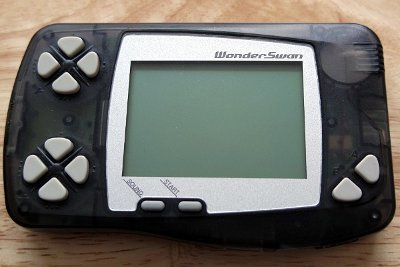 So that's a short history of the WonderSwan. But perhaps the most interesting thing about the WonderSwan saga is the story of what might have been. Around the same time as the WonderSwan's early development, a planned merger between Sega and Bandai looked to be on the cards. However, it was not to be and the deal fell through. But in an alternate reality, could the WonderSwan have carried the Sega name? Maybe. I like to believe that somewhere out there in the multiverse is a Game Gear II, designed by a former Nintendo heavyweight, released worldwide and with the full backing of Sega's in-house game designers behind it. An exciting prospect? I think so. I mean, who wouldn't have liked to see those two old rivals duking it out for the last time?
So that's a short history of the WonderSwan. But perhaps the most interesting thing about the WonderSwan saga is the story of what might have been. Around the same time as the WonderSwan's early development, a planned merger between Sega and Bandai looked to be on the cards. However, it was not to be and the deal fell through. But in an alternate reality, could the WonderSwan have carried the Sega name? Maybe. I like to believe that somewhere out there in the multiverse is a Game Gear II, designed by a former Nintendo heavyweight, released worldwide and with the full backing of Sega's in-house game designers behind it. An exciting prospect? I think so. I mean, who wouldn't have liked to see those two old rivals duking it out for the last time?
In many ways, the WonderSwan epitomises Yokoi's "Lateral thinking with withered technology" ethos better than any other handheld. Firstly, the console has incredible battery life. All models run on just one AA battery and can reportedly last between 30 and 40 hours (for the mono version) and up to 15 hours for the later colour / crystal models. To my knowledge, never before (or since) has any portable system been able to better or equal it. Secondly, like the original Game Boy before it, it was cheaper than any of its nearest rivals. Thirdly, with its landscape and portrait playing modes, it was innovative*. And finally, it's truly portable and easily fits in the pocket. It's the ultimate portable. In my opinion, Nintendo themselves woudn't release a worthy update to the Game Boy line until 2003 with the GBA SP. But Bandai beat them to it.
It's also a very aesthetically pleasing looking console, with its sleek looking curves. Like other tech of the era it comes in a wide variety of pretty colours (sadly, mine is the nondescript black model). In my opinion, only the Game Gear can really rival its beauty. But there are some downsides to the design.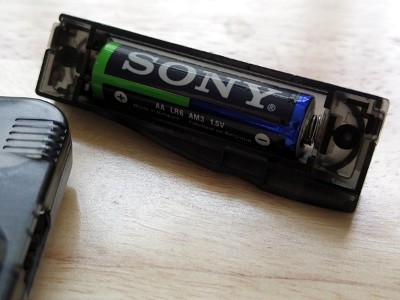 To begin with, the battery enclosure juts out with a bulge, making the console a little uncomfortable to hold at times. To remedy this unsightly bump, Sammy released a rechargeable battery that would fit snugly to the system's profile. If you can find one for a reasonable price, I'm doubtful it would still hold a charge. And the charger is even rarer still. As far as I know, these rechargeables are just “gumstick” batteries (the kind used in higher end Sony Walkmans) in a custom plastic shell, so it may be possible to revive a dead battery with a modern replacement. But it's plain they did not sell well and I think it's better just to stick with a AA.
To begin with, the battery enclosure juts out with a bulge, making the console a little uncomfortable to hold at times. To remedy this unsightly bump, Sammy released a rechargeable battery that would fit snugly to the system's profile. If you can find one for a reasonable price, I'm doubtful it would still hold a charge. And the charger is even rarer still. As far as I know, these rechargeables are just “gumstick” batteries (the kind used in higher end Sony Walkmans) in a custom plastic shell, so it may be possible to revive a dead battery with a modern replacement. But it's plain they did not sell well and I think it's better just to stick with a AA.
(Various companies would go on to release other accessories for the console, from typical items such as link cables and headphone adapters, to unusual accessories like the WonderWitch; a game development cart, WonderGate; internet access via a mobile phone and WonderBorg; a programmable robotics kit. There's also a sonar for fishermen)
The controls are also somewhat less than optimal, with buttons awkwardly placed when playing in landscape and in the vertical position too (with the controls becoming even more cramped). It's not long before my ageing hands begin to weary. That said, being a device aimed squarely at Japanese children or only intended to be played for short periods at a time, I suppose it's fair to excuse these issues.
But enough about the console, the games are what's really important. So how do they stack up against the competition? Here are some mini-reviews of a few of the games in my modest collection:
Gunpey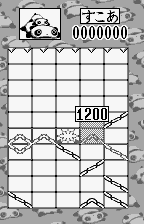 Gunpey (named in posthumous honour for Gunpei Yokoi) is a puzzle game from Koto Laboratory that first appeared as a keychain LCD game called Henoheno. It would later make its debut on the WonderSwan and later still go on to receive ports to both the Nintendo DS and Sony PSP. The concept is pretty simple: various V-shaped and diagonal lines appear at the bottom of the screen and gradually make their way towards the top of the screen. Your goal is to shuffle and connect each line together from the left side of the screen to the right to make them disappear. The more lines you can tie into a combo, the higher the score. Speed increases as you progress. If any line is allowed to reach the top of the screen, it's game over. It's a simple idea, but it makes for a very challenging puzzle game. I seem to be very bad at it, but it's still fun to play. One of the cheaper games to collect and a must own. I have the Tarepanda No Gunpey edition and as far as I can tell, besides the Japanese language in the menus and the Tarepanda theme, there is no significant difference between the two games.
Gunpey (named in posthumous honour for Gunpei Yokoi) is a puzzle game from Koto Laboratory that first appeared as a keychain LCD game called Henoheno. It would later make its debut on the WonderSwan and later still go on to receive ports to both the Nintendo DS and Sony PSP. The concept is pretty simple: various V-shaped and diagonal lines appear at the bottom of the screen and gradually make their way towards the top of the screen. Your goal is to shuffle and connect each line together from the left side of the screen to the right to make them disappear. The more lines you can tie into a combo, the higher the score. Speed increases as you progress. If any line is allowed to reach the top of the screen, it's game over. It's a simple idea, but it makes for a very challenging puzzle game. I seem to be very bad at it, but it's still fun to play. One of the cheaper games to collect and a must own. I have the Tarepanda No Gunpey edition and as far as I can tell, besides the Japanese language in the menus and the Tarepanda theme, there is no significant difference between the two games.
Densha De Go 1 + 2 This is a very Japanese game. I can't think of any other nation on earth that would try to make an arcade game out of a train simulator. Probably one of the more niche games in my collection and while it may not appeal to everybody, I think it's great. As is the case with many arcade games, it is very, very unforgiving. The goal is to drive your train through a sucession of stations and to make it to the end of your route with all your points intact. Points are deducted for arriving late, arriving too early, going over the speed limit and not stopping the train in the correct place. There are precious few opportunities to replenish these deducted points, making for a very challenging experience. Honestly, you will feel like a fully qualified train driver after playing this! It feels like a real achievment to be awarded a star for a perfect station stop and if you can make it to the end without a single game over, you'll be treated to the “good” ending: a catchy 8-bit rendition of the Densha De Go theme tune. I think it's best to start with the first game of the series, since it's easier to find at a reasonable price and a little less brutally difficult than the sequel. DENSHA DE, DENSHA DE, DENSHA DE, DENSHA DE, GO GO GO GO!!!
This is a very Japanese game. I can't think of any other nation on earth that would try to make an arcade game out of a train simulator. Probably one of the more niche games in my collection and while it may not appeal to everybody, I think it's great. As is the case with many arcade games, it is very, very unforgiving. The goal is to drive your train through a sucession of stations and to make it to the end of your route with all your points intact. Points are deducted for arriving late, arriving too early, going over the speed limit and not stopping the train in the correct place. There are precious few opportunities to replenish these deducted points, making for a very challenging experience. Honestly, you will feel like a fully qualified train driver after playing this! It feels like a real achievment to be awarded a star for a perfect station stop and if you can make it to the end without a single game over, you'll be treated to the “good” ending: a catchy 8-bit rendition of the Densha De Go theme tune. I think it's best to start with the first game of the series, since it's easier to find at a reasonable price and a little less brutally difficult than the sequel. DENSHA DE, DENSHA DE, DENSHA DE, DENSHA DE, GO GO GO GO!!!
Tetris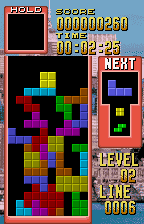 I love this game. Tetris is actually my favourite game of all time and this version is one of the best I've ever played. Shame then, that few people outside Japan even know it exists. It keeps things simple, with only the core marathon, 40 line and 3 minute game modes included. Some people may find this a little spartan but I like the purity. I rarely ever play the extraneous modes included in later Tetris games, anyway. What else is there to say? It's just Tetris and Tetris is enough. Interestingly, the main theme in the game is identical to the theme from the first Famicom Tetris and is not the more familiar Korobeiniki. So I guess this is the “Tetris theme” to Japanese gamers? Notably, Tetris is also the last mono WonderSwan compatible game (released suprisingly late in 2002) and the first “guideline” version of Tetris to hit shelves in Japan.
I love this game. Tetris is actually my favourite game of all time and this version is one of the best I've ever played. Shame then, that few people outside Japan even know it exists. It keeps things simple, with only the core marathon, 40 line and 3 minute game modes included. Some people may find this a little spartan but I like the purity. I rarely ever play the extraneous modes included in later Tetris games, anyway. What else is there to say? It's just Tetris and Tetris is enough. Interestingly, the main theme in the game is identical to the theme from the first Famicom Tetris and is not the more familiar Korobeiniki. So I guess this is the “Tetris theme” to Japanese gamers? Notably, Tetris is also the last mono WonderSwan compatible game (released suprisingly late in 2002) and the first “guideline” version of Tetris to hit shelves in Japan.
Crazy Climber Crazy Climber is considered a minor arcade classic within its native Japan but is hardly known elsewhere (I only discovered the game after seeing Arino tackle the Famicom conversion in an episode of GameCenter CX). As a result, it is one of the more desirable (and thus pricier) games in my collection. One could be forgiven for thinking the WonderSwan was invented to host Crazy Climber, the vertical mode with its dual control system makes the console an ideal home. It takes a little while to get used to the unique control scheme (to climb, you hit up, up, down, down on the left and right controls alternately to move your arms and legs). Being a classic arcade game, it should go without saying that this game is very difficult. I can just about make it to the second screen before game over. Still, it has that fun "just one more go" quality all the best arcade games have. The only bad thing I can say about this game? The blurry dotmatrix screen of the WonderSwan mono makes falling objects near impossible to see, causing lots of cheap deaths. Still, I recommend picking this up.
Crazy Climber is considered a minor arcade classic within its native Japan but is hardly known elsewhere (I only discovered the game after seeing Arino tackle the Famicom conversion in an episode of GameCenter CX). As a result, it is one of the more desirable (and thus pricier) games in my collection. One could be forgiven for thinking the WonderSwan was invented to host Crazy Climber, the vertical mode with its dual control system makes the console an ideal home. It takes a little while to get used to the unique control scheme (to climb, you hit up, up, down, down on the left and right controls alternately to move your arms and legs). Being a classic arcade game, it should go without saying that this game is very difficult. I can just about make it to the second screen before game over. Still, it has that fun "just one more go" quality all the best arcade games have. The only bad thing I can say about this game? The blurry dotmatrix screen of the WonderSwan mono makes falling objects near impossible to see, causing lots of cheap deaths. Still, I recommend picking this up.
Mingle Magnet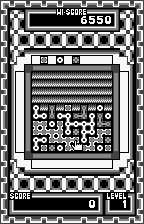 This is a unique puzzle game from HAL Laboratory, Inc (yes, that HAL Laboratory). The goal here is to link blocks of the same kind into long chains which can then be cleared from the screen with your cursor. The longer the chain, the higher the score. A magnet can be activated on each side of the square playing field to attract the blocks to it (this is how long chains can be made) but you must be careful not to arrange the blocks in a way that the next block to fall will reach the edge of the playing area. If you do, it will be game over. It's not easy to explain... That's the best I can do. It's a puzzle game that I've never seen anywhere else and worth a play if you're a puzzle fanatic. Despite being unique, from a reasonably well known developer and exclusive to the WonderSwan (as far as I know), this is one of the more affordable games out there.
This is a unique puzzle game from HAL Laboratory, Inc (yes, that HAL Laboratory). The goal here is to link blocks of the same kind into long chains which can then be cleared from the screen with your cursor. The longer the chain, the higher the score. A magnet can be activated on each side of the square playing field to attract the blocks to it (this is how long chains can be made) but you must be careful not to arrange the blocks in a way that the next block to fall will reach the edge of the playing area. If you do, it will be game over. It's not easy to explain... That's the best I can do. It's a puzzle game that I've never seen anywhere else and worth a play if you're a puzzle fanatic. Despite being unique, from a reasonably well known developer and exclusive to the WonderSwan (as far as I know), this is one of the more affordable games out there.
Tane O Maku Tori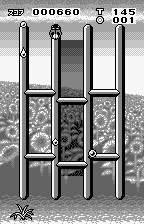 The only game developed by Ludic, the title of this game apparently roughly translates as "Seed Planting Bird". It's another unique puzzler, with similar mechanics to a Pipe Mania style game and a WonderSwan exclusive, too. In this game, your job is to shift platforms to guide drops of water towards a waiting seed, in order to see it blossom into a beautiful flower. Things are made tricky by a parade of critters prowling the stage for water to drink or plants to munch on and you need to ensure you don't unwittingly guide one of these creatures towards your seedlings. You can also direct water droplets together to make larger water drops for higher scores and quicker level completion. As the levels progress, there are more critters to manage and plants to sprout. This game is worth hunting down complete in box because it comes packaged with a charming little children's picture book (why do Japanese gamers get all the goodies?).
The only game developed by Ludic, the title of this game apparently roughly translates as "Seed Planting Bird". It's another unique puzzler, with similar mechanics to a Pipe Mania style game and a WonderSwan exclusive, too. In this game, your job is to shift platforms to guide drops of water towards a waiting seed, in order to see it blossom into a beautiful flower. Things are made tricky by a parade of critters prowling the stage for water to drink or plants to munch on and you need to ensure you don't unwittingly guide one of these creatures towards your seedlings. You can also direct water droplets together to make larger water drops for higher scores and quicker level completion. As the levels progress, there are more critters to manage and plants to sprout. This game is worth hunting down complete in box because it comes packaged with a charming little children's picture book (why do Japanese gamers get all the goodies?).
Honourable Mentions: Magical Drop, Puyo Puyo 2, Wonder Stadium 99, Shanghai Pocket, Side Pocket, Digital Monsters ver. WonderSwan (these games are decent but unexciting or widely available on other platforms, but worth picking up if the price is right)
So if you want to try the WonderSwan, mono systems are the cheapest and most readily available model, typically priced anywhere between £5-£20 for just the console in average condition (with no box). Be aware that cheaper "junk" consoles on ebay will likely need some repair (with bad screen burn to the polariser being the main issue). Ebay prices for games vary wildly but if you don't mind loose carts with slightly damaged labels, you can build up a decent sized collection of games for just £2-£5 a game (Note: This used to be true, but no longer seems to be the case. Supplies have dried up somewhat). Some of the more desirable games do come up for sale for reasonable amounts if you are patient (between the £10-£15 range). Just be wary of chancers trying to make a quick buck from the foolish. That said, there are some games that will pretty much never sell for less than £30-£40 (especially games that appeal to both Japanese and western gamers). So keep that in mind, there are some games you might want to play that may be forever beyond your budget. It's fair to say there are not too many bargains to be had.
In reality, the WonderSwan is a hard system to unreservedly recommend. It's a bit of a flawed masterpiece. Many of the system's games and exclusives have long been available on other platforms for much more reasonable prices, the game library is very Japanese text heavy and the more desirable games tend to be way out of a curiosity seeker's price range. But for me, it's got Tetris, Densha De Go, Puyo Puyo 2, Crazy Climber and enough unique puzzle games to be worthy of my attention.
I have just one final thing to say. The WonderSwan has become the console I'm most likely to take with me when I'm leaving the house. For a portable system, I can't think of a higher praise than that.
*The Atari Lynx had a similar idea, but it was geared more towards accommodating left-handed gamers.
Further Information:
WonderSwan Wiki
Swan of Wonders: English language fan site
Gunpei Yokoi's final games (beforemario)
Swan Song: Yanik Magnan Reviews every game in chronological order
+--+--+--+--+--+--+--+--+--+--+--+--+--+--+
All Screenshots taken from mobygames.com